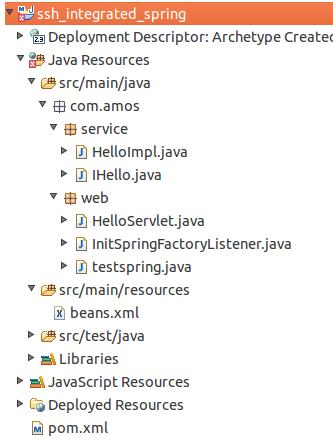使用spring 4.0 + maven 构建超简单的web项目
一.需求
使用spring去管理web项目,是目前非常流行的一种思路,本文将介绍使用maven+spring 4.0.2 来构建一个简单的web项目.
二.实现
1.新建一个maven项目,如下图所示:

这里因为是构建web项目,所以,选择的是webapp.
项目的架构图:

2.在pom.xml中添加所依赖的jar包,如下所示:
<project xmlns="http://maven.apache.org/POM/4.0.0" xmlns:xsi="http://www.w3.org/2001/XMLSchema-instance"
xsi:schemaLocation="http://maven.apache.org/POM/4.0.0 http://maven.apache.org/maven-v4_0_0.xsd">
<modelVersion>4.0.0</modelVersion>
<groupId>com.amos</groupId>
<artifactId>ssh_integrated</artifactId>
<packaging>war</packaging>
<version>0.0.1-SNAPSHOT</version>
<name>ssh_integrated Maven Webapp</name>
<url>http://maven.apache.org</url>
<dependencies>
<dependency>
<groupId>org.springframework</groupId>
<artifactId>spring-web</artifactId>
<version>4.0.2.RELEASE</version>
</dependency>
<dependency>
<groupId>junit</groupId>
<artifactId>junit</artifactId>
<version>3.8.1</version>
<scope>test</scope>
</dependency>
<dependency>
<groupId>org.springframework</groupId>
<artifactId>spring-context</artifactId>
<version>4.0.2.RELEASE</version>
</dependency>
</dependencies>
<build>
<finalName>ssh_integrated_spring</finalName>
</build>
</project>
3.新建一个接口com.amos.service.IHello.java,并实现接口.
package com.amos.service;
public interface IHello {
public String sayHi();
}
com.amos.service.HelloImpl.java
package com.amos.service;
import java.util.Date;
public class HelloImpl implements IHello{
private String msg;
public void setMsg(String msg) {
this.msg = msg;
}
public String sayHi() {
return "当前时间:"+new Date()+" msg:"+msg;
}
}
4.新建一个Servlet,并实现此Servlet
com.amos.web.HelloServlet
package com.amos.web;
import java.io.IOException;
import javax.servlet.ServletException;
import javax.servlet.annotation.WebServlet;
import javax.servlet.http.HttpServlet;
import javax.servlet.http.HttpServletRequest;
import javax.servlet.http.HttpServletResponse;
import org.springframework.context.ApplicationContext;
import org.springframework.web.context.support.WebApplicationContextUtils;
import com.amos.service.IHello;
@WebServlet(name="HelloServlet",urlPatterns={"/hello"})
public class HelloServlet extends HttpServlet {
private static final long serialVersionUID = 2801654413247618244L;
private IHello hello; protected void doGet(HttpServletRequest req, HttpServletResponse resp) throws ServletException, IOException { //方法1,使用传统方式去加载beans.xml,每次请求时加载
//ApplicationContext applicationContext = new ClassPathXmlApplicationContext("beans.xml"); //方法2,使用监听器的方式加载beans.xml,在一启动的时候就加载监听器,避免多次加载,提高效率
//ApplicationContext applicationContext = (ApplicationContext) this.getServletContext().getAttribute("SpringApplicationContext"); //方法3,使用spring自带的监听器去加载beans.xml
//ApplicationContext applicationContext = (ApplicationContext) this.getServletContext().getAttribute(WebApplicationContext.ROOT_WEB_APPLICATION_CONTEXT_ATTRIBUTE);
//使用webapplicationcontextutils这个工具类可以很方便的获取ApplicationContext,只需要传入servletContext
ApplicationContext applicationContext = WebApplicationContextUtils.getRequiredWebApplicationContext(this.getServletContext()); hello = applicationContext.getBean(IHello.class);
String sayHi = hello.sayHi();
System.err.println("sayHi:" + sayHi);
resp.setContentType("text/html;charset=utf-8");
resp.getWriter().write("<h2>" + sayHi + "</h2>");
}
}
注:这里要注意的是实现spring管理Bean的三种方式.
第一种:最传统的方式,同时也是效率最低的一种,因为,每次发一个请求都要重新加载一次,而且对于不同的Servlet的要每个都去加载,会大大降低效率.
第二种:使用监听器来实现加载beans.xml,每次项目启动的时候加载一次就可以了.这样大提高了效率.
com.amos.web.InitSpringFactoryListener.java
package com.amos.web; import javax.servlet.ServletContextEvent;
import javax.servlet.ServletContextListener;
import org.springframework.context.ApplicationContext;
import org.springframework.context.support.ClassPathXmlApplicationContext;
public class InitSpringFactoryListener implements ServletContextListener {
public InitSpringFactoryListener() {
} public void contextInitialized(ServletContextEvent arg0) {
//这里将加载beans.xml加载到内存中,放到servletcontext中,名称可以随便取,这里取为SpringApplicationContext,
ApplicationContext applicationContext = new ClassPathXmlApplicationContext("beans.xml");
arg0.getServletContext().setAttribute("SpringApplicationContext", applicationContext);
}
public void contextDestroyed(ServletContextEvent arg0) {
}
}
同时,web.xml中要定义一个listener属性.
<!-- 自己去写一个监听器来实现加载beans.xml,进而启动spring容器 -->
<!--
<listener>
<listener-class>com.amos.web.InitSpringFactoryListener</listener-class>
</listener> -->
第三种:针对第二种方法,其实spring中已经封装好了一种监听器,人工去配置即可,原理和第二种方法一致.
只需要在web.xml中加入如下代码即可.
<!-- 使用spring自带的监听器,其默认加载的是WEB-INF下的applicationContext.xml -->
<listener>
<listener-class>org.springframework.web.context.ContextLoaderListener</listener-class>
</listener>
但运行进会报如下错误:
org.springframework.beans.factory.BeanDefinitionStoreException: IOException parsing XML document from ServletContext resource [/WEB-INF/applicationContext.xml]; nested exception is java.io.FileNotFoundException: Could not open ServletContext resource [/WEB-INF/applicationContext.xml]
at org.springframework.beans.factory.xml.XmlBeanDefinitionReader.loadBeanDefinitions(XmlBeanDefinitionReader.java:343)
at org.springframework.beans.factory.xml.XmlBeanDefinitionReader.loadBeanDefinitions(XmlBeanDefinitionReader.java:303)
at org.springframework.beans.factory.support.AbstractBeanDefinitionReader.loadBeanDefinitions(AbstractBeanDefinitionReader.java:180)
at org.springframework.beans.factory.support.AbstractBeanDefinitionReader.loadBeanDefinitions(AbstractBeanDefinitionReader.java:216)
at org.springframework.beans.factory.support.AbstractBeanDefinitionReader.loadBeanDefinitions(AbstractBeanDefinitionReader.java:187)
at org.springframework.web.context.support.XmlWebApplicationContext.loadBeanDefinitions(XmlWebApplicationContext.java:125)
at org.springframework.web.context.support.XmlWebApplicationContext.loadBeanDefinitions(XmlWebApplicationContext.java:94)
at org.springframework.context.support.AbstractRefreshableApplicationContext.refreshBeanFactory(AbstractRefreshableApplicationContext.java:129)
at org.springframework.context.support.AbstractApplicationContext.obtainFreshBeanFactory(AbstractApplicationContext.java:540)
........
Caused by: java.io.FileNotFoundException: Could not open ServletContext resource [/WEB-INF/applicationContext.xml]
at org.springframework.web.context.support.ServletContextResource.getInputStream(ServletContextResource.java:141)
at org.springframework.beans.factory.xml.XmlBeanDefinitionReader.loadBeanDefinitions(XmlBeanDefinitionReader.java:329)
... 22 more
说找不到applicationContext.xml文件,那么如何解决这个问题呢?
他说找不到,那就在WIB-INF目录下建一个即可.
然后引入自定义的beans.xml即可.
<?xml version="1.0" encoding="UTF-8"?>
<beans xmlns="http://www.springframework.org/schema/beans"
xmlns:xsi="http://www.w3.org/2001/XMLSchema-instance" xmlns:context="http://www.springframework.org/schema/context"
xmlns:tx="http://www.springframework.org/schema/tx" xmlns:aop="http://www.springframework.org/schema/aop"
xsi:schemaLocation="http://www.springframework.org/schema/beans
http://www.springframework.org/schema/beans/spring-beans-4.0.xsd
http://www.springframework.org/schema/context
http://www.springframework.org/schema/context/spring-context-4.0.xsd
http://www.springframework.org/schema/tx
http://www.springframework.org/schema/tx/spring-tx-4.0.xsd
http://www.springframework.org/schema/aop
http://www.springframework.org/schema/aop/spring-aop-4.0.xsd
">
<import resource="classpath:beans.xml"/>
</beans>
这个时候问题解决.
这里HelloSerlvet中如何获取对应的ApplicationContext呢?
//方法3,使用spring自带的监听器去加载beans.xml
//ApplicationContext applicationContext = (ApplicationContext) this.getServletContext().getAttribute(WebApplicationContext.ROOT_WEB_APPLICATION_CONTEXT_ATTRIBUTE);
这个是需要查看源码才能发现其属性名称,所以比较麻烦.这里还有一种较简便的方法,如下所示:
//使用webapplicationcontextutils这个工具类可以很方便的获取ApplicationContext,只需要传入servletContext
ApplicationContext applicationContext = WebApplicationContextUtils.getRequiredWebApplicationContext(this.getServletContext());
第三种方法,基本上配置完毕,但还会感觉很不爽,因为还要新建一个applicationContext.xml去专门import bean.xml,是相当讨厌的.
其实还可以在web.xml中配置自定义的xml文件名称,如下所示:
<!-- 配置spring的加载文件路径及文件名称 -->
<context-param>
<param-name>contextConfigLocation</param-name>
<param-value>classpath:beans.xml</param-value>
</context-param>
org.springframework.web.context.ContextLoaderListener中有这样一段说明:
<p>Processes a {@link #CONFIG_LOCATION_PARAM "contextConfigLocation"}
* context-param and passes its value to the context instance, parsing it into
* potentially multiple file paths which can be separated by any number of
* commas and spaces, e.g. "WEB-INF/applicationContext1.xml,
* WEB-INF/applicationContext2.xml". Ant-style path patterns are supported as well,
* e.g. "WEB-INF/*Context.xml,WEB-INF/spring*.xml" or "WEB-INF/**/*Context.xml".
* If not explicitly specified, the context implementation is supposed to use a
* default location (with XmlWebApplicationContext: "/WEB-INF/applicationContext.xml").
*
可以自定义spring默认加载的xml文件的名称,可以以逗号和空格进行分隔,也可以使用Ant类型的去标记.xml如,WEB-INF/spring*.xml
否则默认的加载的就是applicationContext.xml.
可以在web.xml中进行配置其参数.
所以,最终的web.xml如下:
<!DOCTYPE web-app PUBLIC
"-//Sun Microsystems, Inc.//DTD Web Application 2.3//EN"
"http://java.sun.com/dtd/web-app_2_3.dtd" >
<web-app>
<display-name>Archetype Created Web Application</display-name>
<!-- 配置spring的加载文件路径及文件名称 -->
<context-param>
<param-name>contextConfigLocation</param-name>
<param-value>classpath:beans.xml</param-value>
</context-param> <!-- 使用spring自带的监听器,其默认加载的是WEB-INF下的applicationContext.xml -->
<listener>
<listener-class>org.springframework.web.context.ContextLoaderListener</listener-class>
</listener> <!-- 自己去写一个监听器来实现加载beans.xml,进而启动spring容器 -->
<!--
<listener>
<listener-class>com.amos.web.InitSpringFactoryListener</listener-class>
</listener> -->
</web-app>
5.运行效果

6.本文源码
https://github.com/amosli/ssh_integrated_spring
使用spring 4.0 + maven 构建超简单的web项目的更多相关文章
- idea+Spring+Mybatis+jersey+jetty构建一个简单的web项目
一.先使用idea创建一个maven项目. 二.引入jar包,修改pom.xml <dependencies> <dependency> <groupId>org. ...
- DOS命令行中用MAVEN构建 Java 和 Java Web 项目
一.Maven的安装 : 1.将 maven3.0解压到任一目录下,如D:\Program Files 2.配置环境变量:变量名: MAVEN_HOME 变量值:D:\Program Files\ ...
- maven创建一个简单的web项目
1.确认maven插件和配置在eclipse中已经完成 如果没完成,可参考这篇博客:http://www.cnblogs.com/mmzs/p/8191979.html 2.在eclipse中用mav ...
- maven-bundle-plugin插件, 用maven构建基于osgi的web应用
maven-bundle-plugin 2.4.0以下版本导出META-INF中的内容到MANIFEST.MF中 今天终于把maven-bundle-plugin不能导出META-INF中的内容到Ex ...
- python超简单的web服务器
今天无意google时看见,心里突然想说,python做web服务器,用不用这么简单啊,看来是我大惊小怪了. web1.py 1 2 3 #!/usr/bin/python import Simp ...
- Django入门第一步:构建一个简单的Django项目
Django入门第一步:构建一个简单的Django项目 1.简介 Django是一个功能完备的Python Web框架,可用于构建复杂的Web应用程序.在本文中,将通过示例跳入并学习Django.您将 ...
- 基于Maven + SSM (Spring、SpringMVC、Mybatis)构建一个简单的测试项目
最近在公司实习期间的培训交流中有机会接触到SSM,然后自己花费1周的时间投入学习.谈不上深刻理解其中原理,所以没有涉及理论知识,只是浅层次的学习如何使用,在此将学习过程记录整理出来,一方面自己备用:另 ...
- Spring Boot(IDEA,Gradle)超详细用户管理项目(一)——Hello World
1.构建工具的配置(Gradle):自定义-所有设置:构建.执行.部署-构建工具-Gradle: 设置Gradle用户主目录:(该目录相当于仓库,gradle将下载所需依赖到此目录下),此目录下可新建 ...
- 基于Maven构建开发第一个Storm项目
前面说过了Storm的测试项目,那么此时我们更想自己写一个小项目来练练手,首先我们自己的Windows系统上首先应该安装好maven,然后启动Eclipse for JavaEE版本,接下来开始建立项 ...
随机推荐
- 深入理解Java内存模型(一)——基础(转)
转自程晓明的"深入理解Java内存模型"的博客 http://www.infoq.com/cn/articles/java-memory-model-1 并发编程模型的分类 在并发 ...
- UNICODE与UTF8和GBK之间的关系
http://wenku.baidu.com/link?url=bheGEzfSjEx-QX-ciME5oKooKYE08_NJZ02l2kKFa7kVZJ4t8Ks2uSNByovgP2QL6btq ...
- mac与php环境
一.目录 apache目录:/etc/apache2/ mysql目录:/usr/local/mysql/ 站点目录:/Library/WebServer/Documents/ 二.mac系统给文件夹 ...
- “NOT_IN”与“NULL”的邂逅
今天处理了一个因“NOT IN”与“NULL”邂逅导致的问题,值得思考和总结,记录在此,供参考.(感谢John抛出的问题) 我们以实验的形式先再现一下这个问题,然后对其分析,最后给出几种解决方案. 1 ...
- 【javascript基础】4、原型与原型链
前言 荒废了好几天,在宿舍闷了几天了,一直想着回家放松,什么也没搞,论文就让老师催吧.不过,闲的没事干的感觉真是不好,还是看看书,写写博客吧,今天和大家说说函数的原型. 原型是什么 第一次看到这个的时 ...
- matlab示例程序--Motion-Based Multiple Object Tracking--卡尔曼多目标跟踪程序--解读
静止背景下的卡尔曼多目标跟踪 最近学习了一下多目标跟踪,看了看MathWorks的关于Motion-Based Multiple Object Tracking的Documention. 官网链接:h ...
- 2015年第六届蓝桥杯C/C++程序设计本科B组决赛
1.积分之谜(枚举) 2.完美正方形 3.关联账户(并查集) 4.密文搜索 5.居民集会 6.模型染色 1.积分之迷 小明开了个网上商店,卖风铃.共有3个品牌:A,B,C.为了促销,每件商品都会返固定 ...
- 64. ZigZag Conversion
ZigZag Conversion The string "PAYPALISHIRING" is written in a zigzag pattern on a given nu ...
- AngularJs 简单实现全选,多选操作
很多时候我们在处理CURD(增删改查)的时候需要实现批量操作数据,这时候就必须使用多选操作. Angular 中实现如下(当然还有很多种比笔者写的更好的方法,这里只是简单的实现.) demo 演示地址 ...
- winform 控件(2)
1.picturebox:图片(属性)sizemide:调整图片 [出现在form的下方]2.imagelist--图片集(在form下方显示)有索引号,记住索引号对应的图片代码:pictureBox ...
